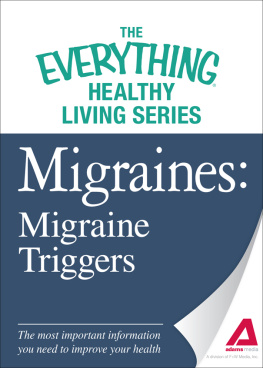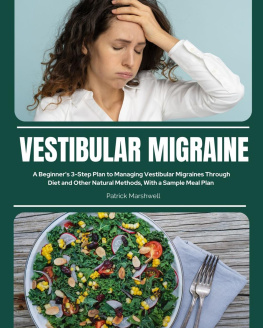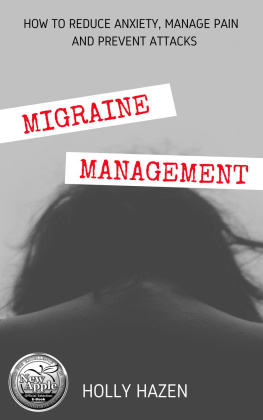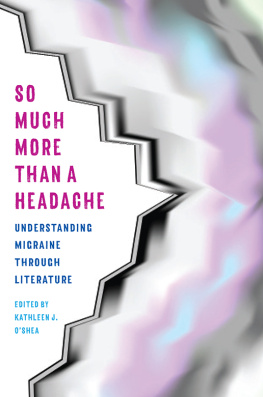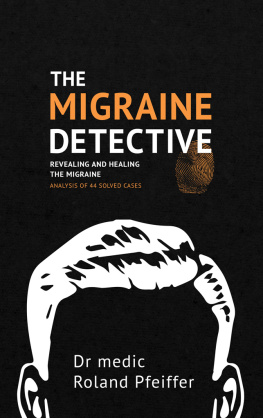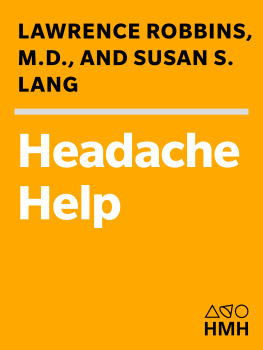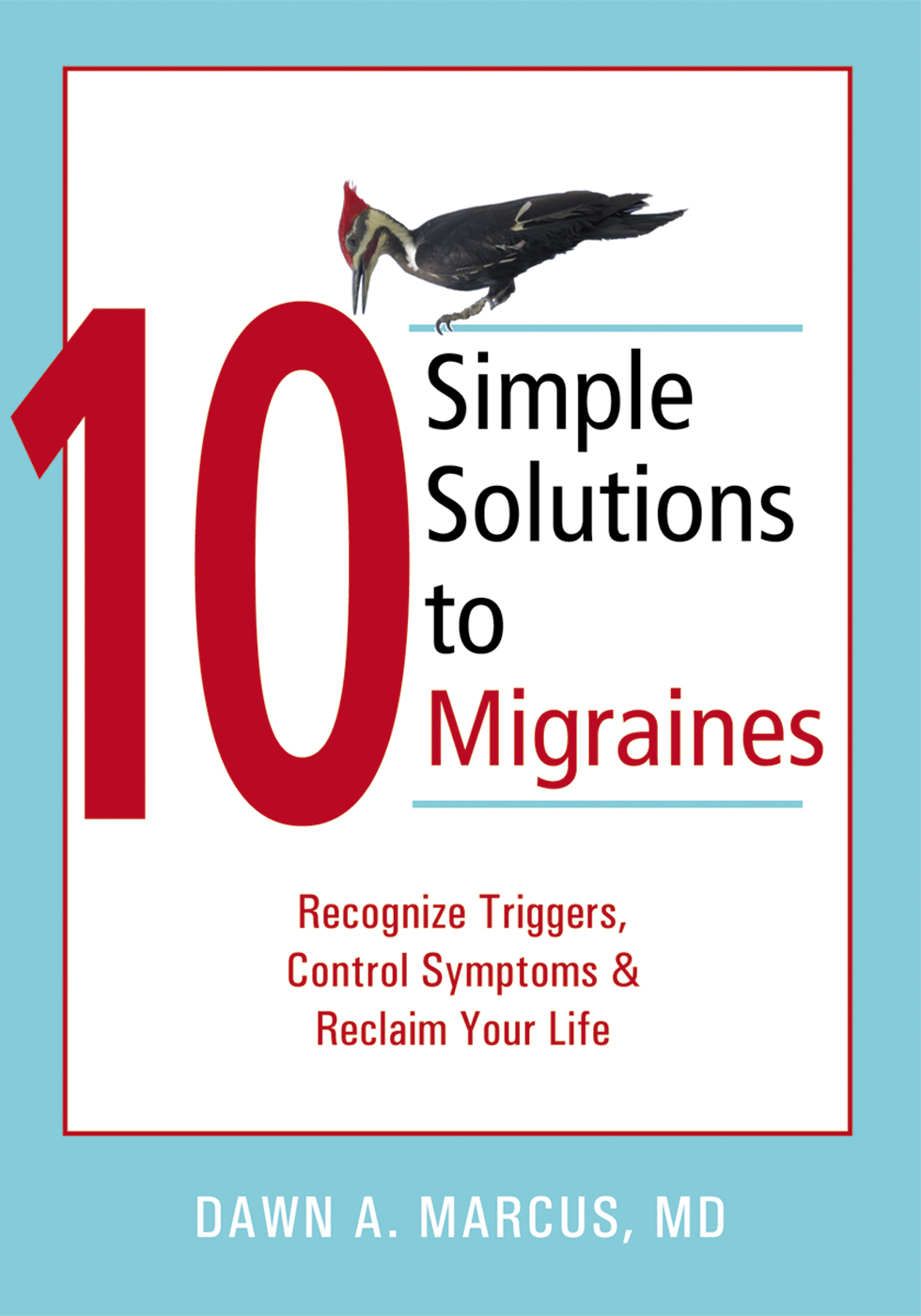
Dawn A. Marcus, MD, is associate professor in the Departments of Anesthesiology and Neurology at the University of Pittsburgh School of Medicine. She is a neurologist with the Pain Evaluation and Treatment Institute in Pittsburgh and coordinator of the institutes Interdisciplinary Headache Clinic. She is an active member of the American Pain Society and the American Association for the Study of Headache. She has received research grants to investigate various issues in headache, including headaches in pregnant women and the mechanisms of recurring headaches.
10 Simple Solutions to Migraines is truly a remarkable book that stands apart from the plethora of self-help book on headaches. I commend her on writing such an important, readable, and useful book and know it will be invaluable to those looking for meaningful help in effectively controlling migraines.
Roger K. Cady, MD, medical director of the Headache Care Center in the Primary Care Network
Migraine is a complex neurobiological disorder. How can one best manage it? Dawn Marcus has provided ten simple solutions to managing migraines. Her new book will help migraine sufferers get a better handle on their migraine attacks; it also provides a thoughtful, step-by-step approach to cooperative management by patients and their headache care providers.
Stephen Silberstein, MD, president of the American Headache Society
An informed patient is an empowered patient. The practical information contained in 10 Simple Solutions to Migraines will enable you to be an active partner in your healthcare. Learning what triggers your migraine, easy lifestyle changes and how to effectively communicate with your healthcare provider will equip you with better ways to control your migraines and regain your quality of life.
Suzanne E. Simons, executive director of the National Headache Foundation

Publishers Note
This publication is designed to provide accurate and authoritative information in regard to the subject matter covered. It is sold with the understanding that the publisher is not engaged in rendering psychological, financial, legal, or other professional services. If expert assistance or counseling is needed, the services of a competent professional should be sought.
Distributed in Canada by Raincoast Books.
Copyright 2006 by Dawn Marcus
New Harbinger Publications, Inc.
5674 Shattuck Avenue
Oakland, CA 94609
Cover design by Amy Shoup; Cover image by James Urbach/Superstock; Acquired by Melissa Kirk; Edited by Jessica Beebe; Text design by Tracy Carlson
All Rights Reserved
Printed in the United States of America
Library of Congress Cataloging-in-Publication Data
Marcus, Dawn A.
10 simple solutions to migraines : recognize triggers, control symptoms, and reclaim your life / Dawn A. Marcus.
p. cm.
ISBN-13: 978-1-57224-441-2
ISBN-10: 1-57224-441-0
1. MigraineTreatment. 2. HeadacheTreatment. I. Title: Ten simple solutions to migraines. II. Title.
RC392.M37 2006
616.84912dc22
2006002531
New Harbinger Publications website address: www.newharbinger.com
Contents
Understand Your Migraine
For years, Ive been trying to keep up my professional life in spite of my headaches. My doctor said the headaches are probably from work stress, but I even get them on weekends and vacations. Ive tried several medications, but nothing seems to help. I miss family and social events, and I even lost a work promotion. I feel like these headaches are controlling my life.
Untreated migraine can seem to control your life dictating if you can go to work or a childs soccer game, limiting what foods you can eat, and causing frustration and depression. The good news for migraine sufferers is that there are a lot of effective treatments available to help prevent and treat headaches. Unfortunately, there is no quick fix or simple cure for migraines. With education and consistent application of headache management techniques, most migraine sufferers can significantly reduce their headaches and the impact migraine has on their lives.
How Do You Know Its Migraine?
There is no X-ray or blood test to identify migraine. Migraine is diagnosed when a person has several of these typical headache features:
- pain on one side of the head.
- pain that feels like a throb or pulse.
- pain that limits activities.
- a need to dim lights or go to a dark room.
- a need to avoid noises or go to a quiet room.
- nausea or vomiting.
- odors like smoke and perfume are nauseating.
- bending over with head between knees worsens pain.
Not everyone with migraine has all of these features. You may have a severe, throbbing pain on both sides of the head that makes you seek a dark, quiet room. Even though the pain affects both sides of the head, most of the headache characteristics are migraine features. You may notice different characteristics with different headache attacks. For example, some migraines may cause throbbing pain and vomiting, while others cause a dull pain without vomiting. Headaches that limit your activities and make you close curtains, turn off the television, and avoid odors are probably also migraines. Remember, you dont have to vomit or even be nauseated for your headache to be a migraine.
What Causes Migraine?
When you see a doctor for migraines, youll probably hear that everything looks normal. Your doctor means that you dont have another serious illness, a brain tumor, an aneurysm, or an infection causing the headache. This doesnt mean that migraine is imaginary. It just means that todays tests arent sensitive enough to find the abnormalities in the body that result in migraine. Research studies have identified several important factors that contribute to migraine, including an inherited headache susceptibility and increased sensitivity of the brain to pain messages.
Headache Susceptibility
Like many health conditions, migraine is probably caused by a combination of genetic and environmental factors. Migraine tends to run in families. About half to two-thirds of migraineurs (people with migraine) have close relatives with migraine. Migraine is more likely to run on the mothers side of the family. A study of over 8,000 adult twin pairs found migraine in about 12 percent (Honkasalo et al. 1995). When one twin had migraine, an identical twin (who shares the same genetics) was over twice as likely to also have migraine compared with a nonidentical twin. This study showed that about half the risk for migraine comes from your genes. The other half comes from environmental factors.
So far, studies have not identified a specific gene abnormality that causes most kinds of migraine. Familial hemiplegic migraine is a rare type of migraine that has been linked to specific gene abnormalities. People with familial hemiplegic (meaning half-body paralysis) migraine experience paralysis or weakness over half of the body during migraine attacks. Other family members will have the same type of migraine attacks with paralysis. In these people, genetic mutations have been found on chromosomes number one and nineteen. Although more typical migraine attacks also run in families, these same chromosome abnormalities have not been seen in typical migraineurs.
Migraine Triggers
If you inherited a susceptibility to migraine, a variety of environmental factors may trigger your headache. As you can see from the table, each trigger usually provokes a migraine for only about 10 to 30 percent of people with migraine (Marcus 2003b).


